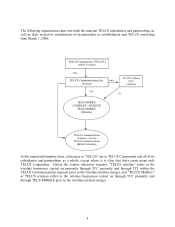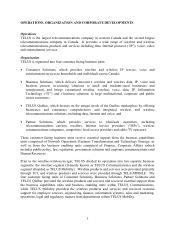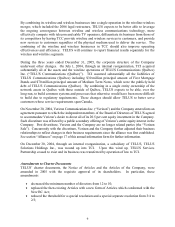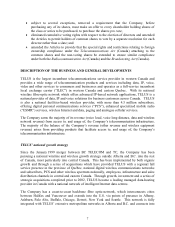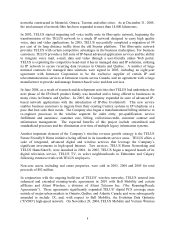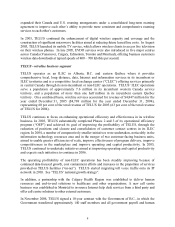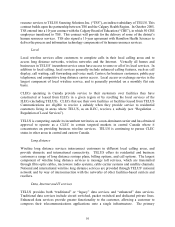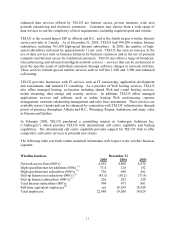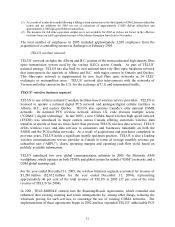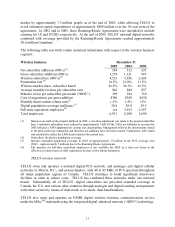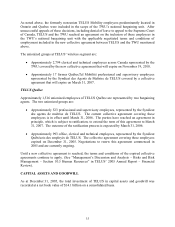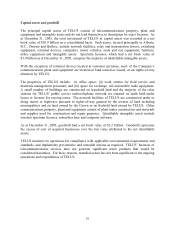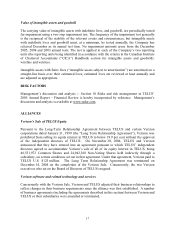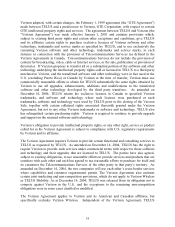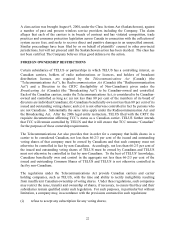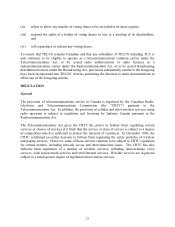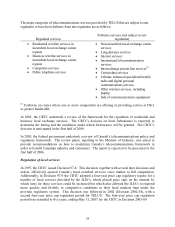Telus 2005 Annual Report Download - page 15
Download and view the complete annual report
Please find page 15 of the 2005 Telus annual report below. You can navigate through the pages in the report by either clicking on the pages listed below, or by using the keyword search tool below to find specific information within the annual report. 14
The Mike network covers the larger population centers and surrounding areas in Alberta, B.C.,
Manitoba, Ontario and Québec (including Toronto and Montréal), and many non-urban areas in
Ontario, Québec and western Canada. The Mike network utilizes frequencies in the 800 MHz
range which have propagation advantages over higher frequencies such as those used in digital
1900 MHz PCS networks, resulting in more cost effective geographic coverage. While the
amount of 800 MHz spectrum licensed to TELUS varies by region, TELUS has in excess of 10
MHz of spectrum available for its Mike network in Montréal, Toronto and Vancouver, Canada’s
three most populous metropolitan areas. The Mike service is marketed primarily through
independent and corporate-owned dealers to businesses and other organizations as a digital PCS-
like service with the added benefit of Mike’s Direct Connect™ Push to Talk™ functionality,
which provides low-cost instant connectivity for work groups.
TELUS also operates analogue specialized mobile radio (“SMR”) systems in most major urban
centres in Canada. TELUS operates paging networks in Alberta, B.C., and eastern Québec.
EMPLOYEE RELATIONS
As at December 31, 2005, TELUS had a total of approximately 29,819 employees, of which
24,177 were regular full-time or regular part-time employees; the balance were temporary
employees. Approximately 14,589 employees were unionized of which approximately 11,778
were part of the wireline business segment and approximately 2,811 were employed in the
wireless business segment.
A labour disruption that began on July 21, 2005 was settled on November 18, 2005, following
the ratification of a new five-year collective agreement covering approximately 14,000
employees (including inactive employees) in both the wireline and wireless business segments
located predominantly in TELUS’ western incumbent region in B.C. and Alberta. The new
agreement, effective November 20, 2005 and expiring November 19, 2010, merged six
previously separate collective agreements into one and applies to all unionized team members in
B.C. and Alberta represented by the Telecommunications Workers Union (“TWU”), as well as
TELUS Mobility team members in central Canada who were included in the scope of the TWU’s
bargaining unit by Canada Industrial Relations Board (“CIRB”) Decisions 1088 and 278.
TELUS– wireline business segment
The TWU represents approximately 10,047 unionized employees in TELUS wireline operations
in Alberta and B.C. These employees are covered by the new collective agreement with the
TWU mentioned above.
TELUS – wireless business segment
TELUS’ wireless operations has approximately 2,811 unionized employees in two separate
bargaining units with the majority of unionized employees included in the TWU’s national
bargaining unit and a smaller number in a separate unit in Québec.


